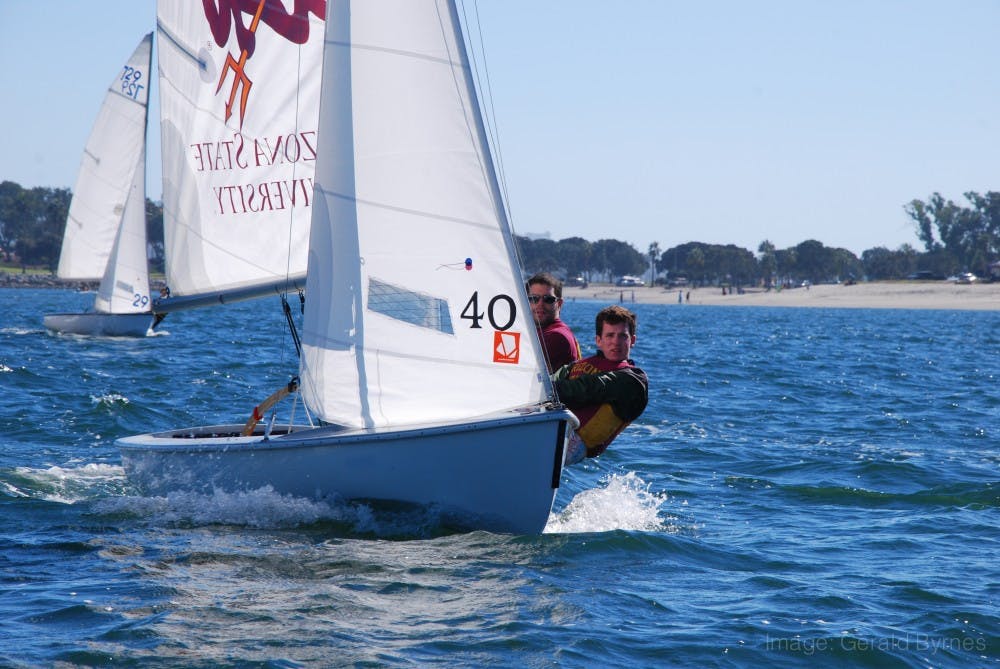The cliché that math and science go hand in hand could never be more right. For junior Gerald Byrnes, he could not thank Sir Isaac Newton enough. When it comes down to it, minute calculations and the laws of physics make the sport of sailing much more of a breeze.
 With the sport of sailing, the angle by which the boat travels is dependent on weight distribution and the position of the steering components—the rudder, centerboard and sails. The smallest disposition can be, according to Byrnes, “a first place finish or you in the back.”
With the sport of sailing, the angle by which the boat travels is dependent on weight distribution and the position of the steering components—the rudder, centerboard and sails. The smallest disposition can be, according to Byrnes, “a first place finish or you in the back.”
“We go way beyond regular sailing,” Byrnes says, a Photography and Biology major. “Sailing is easy but competitive. It’s like driving a car, but when it comes to racing, it requires more skill.”
Positioning at the correct angle is vital. The competitive side of sailing in a nutshell is a circuit race, a designated course in the water. To generate maximum force to the fiberglass vessel, you need to position the boat to the highest angle to the wind; the boats, Club Flying Juniors, can travel at a high of roughly six knots, seven miles per hour.
In the gist of it all: “The wind flows around the sail generating lift. The centerboard engineers lift on a different angle. The vectors add up and pull the boat forward,” Byrnes says. These are the basics in operating the 13 foot, 200 pound vessel. It “goes beyond.”
“Hiking” is maneuvering the boat throughout the race, which proves to be the brunt of the sport. Maneuvering the boat is primarily done with an applied force: the crews’ body weights. The boat moves where the center of effort is. In most instances, the crew hangs off the edge using footholds in the boat as their support. This applies an artificial wind to the boat, generating more power to turn.
The key is to keep the boat as level as possible to generate maximum speed but to maneuver it in the most effective way. Having a well-versed feel for how to maneuver the boat is the utmost quality to have. Because sailing is about having “the right of way,” the slightest misperception can land your boat into an opposing boat. The penalty would be circling your boat twice in place before resuming; hitting a marker is half the cost.
“The basic principles are very easy to learn but it takes time to finesse. Everyone is out there using the same equipment so it’s how you use it. It’s not the boat, it’s the sailor,” Byrnes says.
Arizona State’s sailing club does not solely have competition sailing. For those with disabilities, there is an adaptive program and for those just looking to learn, the club also fosters teaching. There are currently seven instructors.
“I see us growing. We have a very young team,” head coach Jake Geller says. “I think people recognize that we’re not a joke anymore.”
Geller had received his undergraduate degree in journalism and received his master’s degree in 2010 from Arizona State University. He had also founded ASU sailing in 2002; then, there were three boats and “about seven or eight people.” Now, the team has expanded—they have seven boats and thirty members.
“I have people say ‘Wow, there’s a big difference from where we started from.’ We’re always looking for new people. We have to work hard. Yes, we practice on what people are struggling with…,” Geller says. “…but you learn when you’re out there and react to what you do.”
Sure, science and math are contributors but when it comes down to it, the sailor’s willingness is everything.
“It’s just an exhilarating feeling, just getting propelled by just the wind and water,” Byrnes says.
Have anything for me? E-mail me at bcapria@asu.edu




